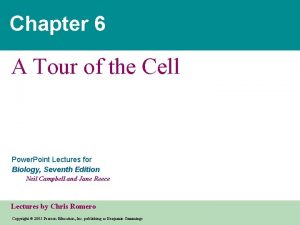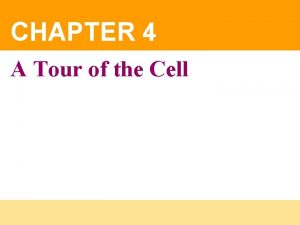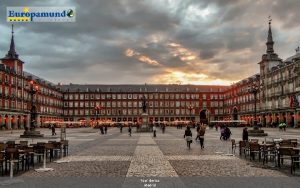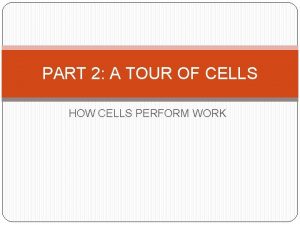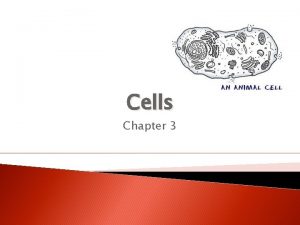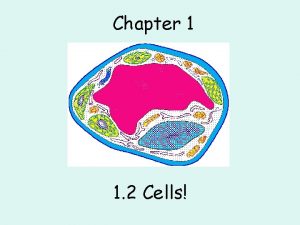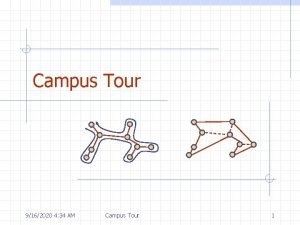CELLS Chapter 4 A Tour of the Cells






























- Slides: 30

CELLS Chapter 4: A Tour of the Cells

I. Cell Theory A. What is it? 1. All living things are made of cells. 2. Existing cells have come from other cells.

Evidence for cell theory 1. When observed, all living things consistently appear to be composed of cells. 2. Made of organelles, but cooperation of all organelles required for life processes. 3. Cell division is evident where spontaneous generation or abiogenesis is not.

Answer in Notebooks: #2. Define the following: Spontaneous Generation: Abiogenesis:

B. Cells are small and their components even smaller molecules ~1 nm membrane thickness ~10 nm viruses ~ 100 nm bacteria ~1 μm organelles – up to 10 μm most cells – up to 100 μm * remember that cells are 3 D objects

scale of universe

10 m Length of some nerve and muscle cells Chicken egg 10 mm (1 cm) 1 mm 100 μm 100 nm 1 nm 0. 1 nm Frog egg Paramecium Human egg Most plant and animal cells Nucleus Most bacteria Mitochondrion Smallest bacteria Viruses Ribosome Proteins Lipids Small molecules Atoms Electron microscope 100 mm (10 cm) Human height Light microscope 1 m Unaided eye Figure 4. 1 e-0

C. Cell size is limited by ratio of surface area to volume. 1. as the size of structure increases the SA: V ratio decreases

The rate of exchange of heat, waste and fuel is a function of Surface Area

Answer in Notebooks: #3. Why is it important to have a larger surface area to volume ratio in cells?

2. Two types of cells: Prokaryotic and Eukaryotic - all cells have plasma membrane, cytoplasm, DNA and ribosomes A. prokaryotic (before nucleus - kernal) 1. no membrane bound organelles such as nucleus to separate DNA from rest of cell a. nucleoid – region of coiled DNA 2. bacteria and archaea (extremely plentiful and diverse) 3. reproduce (divide) via binary fission a. DNA replicates then cell splits in two each containing the DNA

Figure 4. 3 -0 Fimbriae Ribosomes Nucleoid Plasma membrane Cell wall Bacterial chromosome A typical rod-shaped bacterium Capsule A colorized TEM of the bacterium Escherichia coli Flagella

B. Eukaryotic Cells (good/true nucleus) 1. contain membrane bound organelles such a nucleus 2. generally larger than prokaryotic


Animal Cell Micrograph

C. Comparing prokaryotic cells to eukaryotic cells Prokaryotic Eukaryotic Small cells (<5 um) Larger cells (>10 um) Always unicellular Often multicellular No nucleus, DNA in nucleoid in cytoplasm DNA in membrane bound nucleus No membrane bound organelles Contains membrane bound organelles No mitochondria Mitochondria present Small ribosomes (70 s) s = svedberg unit of measure of size of organelles Larger ribosomes (80 s) Cell division via binary fission Cell division via mitosis Mostly asexual reproduction though some Asexual and sexual reproduction gene exchange via conjugation

Answer in Notebooks: #4. Compare and Contrast Prokaryotic vs. Eukaryotic Cells Use a Venn Diagram Pro Both Eu

Genetic Control - Houses DNA - Brain Nucleus

s e m o s o Protein Synthesis b i R

Endoplasmic Reticulum Rough ER: Transports materials and ribosomes produce proteins in cisternae Smooth ER: No ribosomes. Makes proteins and lipids that are exported, controls Calcium level in muscles, and detoxifies poisons, alcohol, and drugs

Golgi Body (Apparatus or Complex) Modifies and packages proteins and carbohydrates for export.

Ly so so me s Ve s icle s Transport Digestive enzymes – digests nutrients and old cell organelles to be recycled s e m o s i Breaks down x o fatty acids r and rids e of toxic P body peroxides


Vac uole s Fill with food being digested and Substances being removed from cell

Energy processing - Powerhouse of the Cell Mitochondria

Chloroplast Contain Chlorophyll that traps sunlight for energy

4. Plant cells vs. animal cells (eukaryotic) Feature Plant Animal Cell wall Present with plasma membrane Not present, only plasma membrane Chloroplasts Present in cells that photosynthesize Not present Carbohydrate storage Starch Glycogen Vacuoles Large and fluid filled Not usually present (sometimes small temporary vacuoles found) Shape Fixed, though often irregular Varied, usually rounded

Figure 4. 4 a Rough endoplasmic reticulum NUCLEUS Nuclear envelope Nucleolus Chromatin Ribosomes CYTOSKELETON Microtubule Microfilament Intermediate filament Peroxisome Smooth endoplasmic reticulum Plasma membrane Golgi apparatus Lysosome Mitochondrion Centrosome with pair of centrioles

Figure 4. 4 b Smooth endoplasmic reticulum NUCLEUS Nuclear envelope Nucleolus Chromatin Rough endoplasmic reticulum Mitochondrion CYTOSKELETON Microfilament Microtubule Central vacuole Ribosomes Chloroplast Cell wall Plasmodesma Cell wall of adjacent cell Golgi apparatus Peroxisome Plasma membrane

Answer in Notebooks: #8. Compare and Contrast Animal vs. Plant Cells Use a Venn Diagram Animal Both Plant
 Shanghai world financial tour eiffel tours petronas
Shanghai world financial tour eiffel tours petronas Tour escort and tour guide
Tour escort and tour guide Dangerous world tour history world tour - hockenheimring
Dangerous world tour history world tour - hockenheimring Chapter 8 cellular reproduction cells from cells
Chapter 8 cellular reproduction cells from cells Intercellular connections
Intercellular connections Chapter 4 a tour of the cell
Chapter 4 a tour of the cell A tour of the cell chapter 4
A tour of the cell chapter 4 Onodi cells
Onodi cells Alpha intercalated cell
Alpha intercalated cell Thyroid parafollicular cells
Thyroid parafollicular cells Somatic cells vs gametes
Somatic cells vs gametes Somatic cells vs germ cells
Somatic cells vs germ cells Red blood cells and white blood cells difference
Red blood cells and white blood cells difference Prokaryote vs eukaryote
Prokaryote vs eukaryote Plant vs animal cell venn diagram
Plant vs animal cell venn diagram Prokaryotic cell
Prokaryotic cell Organelle trail
Organelle trail Masses of cells form and steal nutrients from healthy cells
Masses of cells form and steal nutrients from healthy cells Younger cells cuboidal older cells flattened
Younger cells cuboidal older cells flattened Prokaryotic cells vs eukaryotic cells
Prokaryotic cells vs eukaryotic cells Prokaryotic cells
Prokaryotic cells Cell substance
Cell substance Hình ảnh bộ gõ cơ thể búng tay
Hình ảnh bộ gõ cơ thể búng tay Ng-html
Ng-html Bổ thể
Bổ thể Tỉ lệ cơ thể trẻ em
Tỉ lệ cơ thể trẻ em Gấu đi như thế nào
Gấu đi như thế nào Tư thế worm breton là gì
Tư thế worm breton là gì Chúa yêu trần thế alleluia
Chúa yêu trần thế alleluia Kể tên các môn thể thao
Kể tên các môn thể thao Thế nào là hệ số cao nhất
Thế nào là hệ số cao nhất




